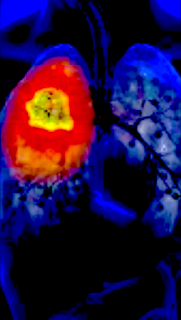 Compared to the other types of cancer, lung cancer is
the deadliest type worldwide with the highest number of casualties.
Compared to the other types of cancer, lung cancer is
the deadliest type worldwide with the highest number of casualties.
This tumour grows when a group of cells develop at an
exorbitant pace and even though lung cancer is most commonly found in smokers
(90%), this tumour can also emerge due to other causes (10%).
Causes are:
- Passive exposure to cigarette smoke.
- Exposure to asbestos, nickel, arsenic, tar, radon gas, etc.
- Environmental pollution linked to a smoking habit.
- Exposure to aromatic hydrocarbons or substances that can form during the incomplete combustion of wood, rubbish, carbon, etc.
SYMPTOMS
Lung cancer hardly presents any symptoms in its
initial phases however, when symptoms do emerge, it will always vary depending
on the affected section of the lung that it emerges in.
Most common symptoms are:
- Cough that never ceases (Lasts more than three weeks), with and without phlegm. This symptom can be found in more than 50% of cases therefore, it is the one that we have to pay more attention to.
- Saliva or phlegm of a pulmonary origin with blood, not emerging from the gums or when coughing.
- Dyspnoea or fatigue. (Shortness of breath)
- Dysphonia or voice alteration. (Hoarse voice)
- Weight loss.
- Constant chest pain that increases when you are breathing deeply or coughing.
- Droopy eyelids or swelling in the face or neck, predominantly due to the compression of the vessels or nerves due to the tumour.
DIAGNOSIS
- Chest X Ray.
- CT or scan.
- Bronchoscopy.
- Biopsy to determine the type of tumour present.
- Others.
TREATMENT
- Surgery.
- Chemotherapy.
- Radiotherapy.
- Immunotherapy.
- Others.
PREVENTION
1. Stop smoking, or never start.
This is the main measure of prevention.
It has been found that the risk of suffering from lung
cancer is reduced by up to 50% when a person has stopped smoking for 10 years.
2. Avoid the exposure of cigarette smoke for
non-smokers or passive smokers.
3. Undertake a regular check up if there is a risk of
suffering from this pathology i.e. smokers or those that have a family history
of suffering from lung cancer and also smoke.
4. Avoid exposition to asbestos, nickel, arsenic, tar,
radon gas, aromatic hydrocarbons, etc.
5. Having a diet rich in fruit and vegetables.
6. Completing physical exercise.
Dr. J. Hurtado Martínez
Medical Director of HealthSalus
